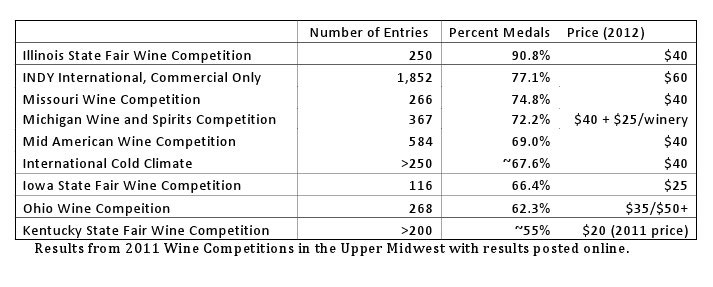How to Make Wine Contests Work for Your Winery
Recently, a former winemaking student asked me, ‘How do I win more gold medals?” I responded by saying ‘Enter more wine competitions.” We laughed and changed the topic. This conversation, although brief, had a lasting effect and caused me to reflect on my own thought process for selecting the competitions that I submit wines to.
I’ve been part of the ‘inner-workings’ of wine competitions for many years. I was part of the team that established the Mid-American Wine Competition in 2006 and coordinated the event for many years. In addition, I’m a judge for numerous other competitions.
There are many reasons for wineries not to enter wine competitions. Dissenters often cite the differences in evaluation between competitions, disagreement with the awards, mishandling of the wines, or incompetence of the competition staff as reasons for not participating.
I can’t refute these concerns nor am I interested in attempting to do so. I have seen ‘mediocre-selling’ wines earn best of show and ‘best-sellers’ earn little more than a bronze or silver. Complaints aside, earning medals is a valuable sales tool which counters one of the core fears of Midwest wine drinkers: Our locally produced wines taste bad.
A winery’s main goal in selecting a wine competition is to sell wine. In today’s global market, making excellent quality wine does not make the wine unique. Very good wine, or at least highly palatable wine, is practically a minimum performance requirement to be competitive.
From there, success in the wine industry becomes highly dependent on sales, marketing, and service. As such, during the start-up years of an operation, I suggest directing a large amount of funds to earning as many medals as possible from a wide variety of competitions. When clients have a display case with bottles tipping over from the weight of medals, then consumers can be assured that the operation makes ‘good quality’ wine…whatever ‘good quality’ means. However, most wineries have identical display cases. As such, this does not differentiate a winery, but establishes that the winery is equal to other producers.
Therefore, the approach to competitions often changes after the medal display case is full (and the winemaker’s ego is delighted.) At this point, the winery could become far more selective with marketing funds. The first wines entered into competitions are usually those with excess stock or short-lived wines.
In addition, wineries may strive to earn a gold medal on each wine produced. Once a wine has a gold medal, the wine may be eligible for retirement from the competition scene. Silver medal winners may be retired too. After all, it is an expensive proposition to continually enter the same wine in different competitions.
Wine competitions can be a balancing act between industry appeasement and professional integrity. I jokingly refer to this balancing act as a ‘happiness index.’ This emotional balancing process is similar to the classification systems of Pomerol and Médoc in Bordeaux. Pomerol recognizes many producers in a continually updated system (a ‘happy’ system), while Médoc has a very short list of chateaus and has scarcely been modified since 1855 (not quite as ‘happy’ a system.)
Naturally, a wine competition would be very successful if it awarded gold medals to all participants; or, eliminated bronze medals and replaced the scoring system with silver, gold, and platinum; or, doubled the number of Best-of-Show awards. While these approaches satisfy industry, it’s important to also consider if the approach dilutes the value of all competitions. Increasing the ‘happiness index’ for wine contest entrants can have an equal and opposite effect on the integrity of the competition.
Insights regarding the hypothetical happiness index in the upper Midwest may be garnered by investigating the percentage of medals awarded. The following table summarizes the 2011 results from the major state competitions in the upper Midwest. The list includes the International Cold Climate Competition, Mid-American Wine Competition (excluding the food-wine pairing competition), Iowa State Fair Wine Competition, Missouri Wine Competition, Illinois State Fair Wine Competition, Michigan Wine and Spirits, INDY International (commercial only), Ohio Wine Competition, and Kentucky State Fair Wine Competition. Specific information was based on information available on the website. The Wisconsin State Fair Wine Competition was not included since the results are not available online. When specific information was missing, the competition was contacted directly. In these instances the approximate information provided was used and the results are denoted with an approximate sign (~). Hopefully, participants in the Illinois State Fair Wine Competition are happy with approximately 90% of entries receiving medals. Ohio and Kentucky wineries may be less than happy with 62.3% and ~55%, respectively.
The ‘happiness index’ may be further evaluated by investigating the distribution of medals awarded. Generally, it would be expected that each higher tier of recognition would have fewer medals; for example, a competition would award the highest number of bronze, fewer silver, even fewer gold, and a small handful of sweepstakes awards. This analysis revealed that a number of competitions, particularly the large competitions, awarded more silver than bronze medals. Participants in Illinois, MAWC, Missouri, and INDY should be happy with nearly half (47.2%) of the total awards being silver compared to a third (32.7%) being bronze.
Another consideration when selecting a wine competition is the judges. The implications of the judge selection process are immense. Judges have diverse philosophical orientations based on their association with the wine industry. Professionals actively involved in wine markets have a different perspective than enthusiasts who primarily purchase wine retail. I seek competitions with a high proportion of judges fully employed in diverse aspects of the wine industry. This includes academia, production, retail/restaurant, and distribution. Each of these professionals adds different strengths and weaknesses to the judging which results in more balanced assessments. I am leery of competitions relying on ‘local wine celebrities.’
Wine competitions function to relate exciting wines to the public. If a winery is undecided between two competitions, then they may elect to submit wines to the event which offers more publicity. Publicity may constitute anything beyond the basic medals awarded. This includes being listed on the competition’s website, press releases, certificates of achievement, etc. Many competitions include fundraisers which allow the public to taste award-winning wines. This is a great way for competitions with limited budgets (which is probably every Midwest competition) to generate additional funds. However, the effect on consumers resulting from such tastings tends to be regional.
The final point is about utilization of wine competitions. Exercise caution before entering a wine into a category with the words ‘other’ or ‘mixed’ in the title. Unfortunately, these categories often function as a deathbed for “interesting”, and sometimes bizarre, wines. The medal counts are notoriously low in these categories. In addition, judges often sigh in grief when they realize they have to taste the ‘labrusca-mead blend with herbal extracts.’ Instead, I strive to have wines entered in a named category.
In the end, there are countless wine competitions soliciting winery participation. These range from the local state fair to broad sweeping events with an international scope. Approaching the multitude of competitions with deliberate action and cautious evaluation enables increased sales and helps position a winery as a quality producer. All competitions vary in relation to the number of medals, the distribution of medals, the judges utilized, and publicity offered. It’s important for wineries to select competitions whose philosophy mirrors their own standards.
 Paul Gospodarczyk, is a Certified Sommelier based in Chicago and Director of Today’s Wine Professional at www.todayswineprofessional.com.
Paul Gospodarczyk, is a Certified Sommelier based in Chicago and Director of Today’s Wine Professional at www.todayswineprofessional.com.
References:
International Cold Climate: http://mngrapegrowers.com/Websites/mgga/images/Competition%20Images/2011%20ICCWC%20Winners%20Press%20Release.pdf
Mid-American Wine Competition: http://www.midamericanwine.org/2011medals/Pages/welcome.aspx
WI State Fair Wine Competition: http://www.wistatefair.com/fair_competitions/judginging_results.html
http://www.wistatefair.com/pdfs/competitions/judging_results/Miscellaneous/Prof_Wine_by_Medal.pdf
http://www.wistatefair.com/pdfs/competitions/judging_results/Miscellaneous/Prof_Wine_by_Winery.pdf
tenbaridgewinery.net/state%20fair%20announcement.doc
Missouri Wine Competition: http://www.missouriwine.org/system/images/46/original/2011%20Winners%204.pdf
http://www.missouriwine.org/industry/industry-happenings
Illinois State Fair Wine Competition:
http://www.illinoiswine.org/pdf/2011-state-fair-results.pdf
INDY International Commercial Wine Competition:
http://www.indyinternational.org/competition/2011/
http://www.indyinternational.org/enter/faq/
Michigan Wine and Spirits Competition:
http://www.michiganwines.com/docs/Competition/2011_medal_winners.pdf
http://www.michiganwines.com/page.php?menu=awards
http://www.michiganwines.com/docs/Industry/entry_form11.pdf
Ohio Wine Competition
http://www.oardc.ohio-state.edu/grapeweb/images/2011_OWC_Official_Results_Booklet.pdf
http://www.oardc.ohio-state.edu/grapeweb/images/2012OWC-OQWEntry_Form.pdf
Kentucky State Fair Wine Competition
http://www.kentuckywine.com/2011/08/17/kentucky-wines-earn-medals-at-kentucky-state-fair/
http://kentuckymonthly.com/wp-content/uploads/pdfs/HSG%20OXtra%20Wine%20Winners.pdf
Iowa State Fair Wine Competition
http://www.iowastatefair.org/downloads/competition/premium-books/commercial-wine-23.pdf




